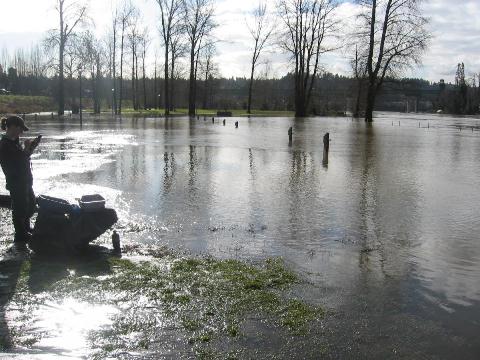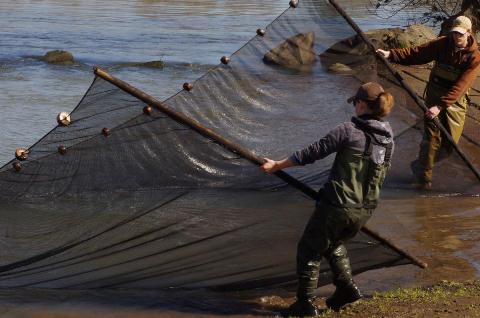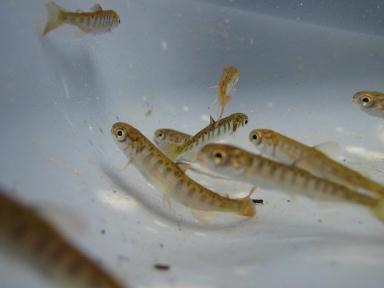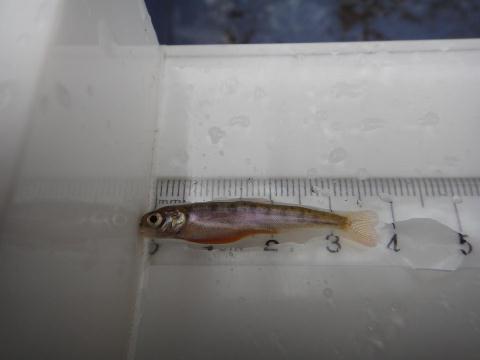Willamette Chinook Fry Investigations
Background
Dispersal of Pacific salmon fry has been attributed to factors such as displacement by high water (Healey 1980; Hartman et al. 1982), and aggression and density dependence (Chapman, 1962; Mason and Chapman 1965). Fry dispersal may also have a genetic component tied to expressions of life histories such as stream- and ocean-type Chinook salmon (Taylor and Larkin 1986; Taylor 1988). Fry migrants have been considered surplus to the population and were assumed to have low survival (Chapman 1966; Crone and Bond 1976; Hartman et al. 1982), although more recent work suggests that these early migrants represent life history variation that contributes to the resilience of populations (Koski 2009). Movement of Chinook fry shortly after emergence has been demonstrated in several populations for both ocean-type fish migrating to estuaries (Reimers 1971; Healey 1980) and for stream-type migrating from spawning areas into lower reaches of spawning rivers or to large mainstem rivers (Lister and Walker 1966; Bjornn 1971; Murphy et al. 1997). Movement of fry may vary within and between populations, which may be related to phenotypic and genotypic differences (Carl and Healey 1954; Bradford and Taylor 1997). Mattson (1962) reported catch of fry in the Willamette River upstream of Willamette Falls in January–March, and Chinook fry were captured at Willamette Falls starting in January and continuing through May (Massey 1967). Although these studies suggest rapid downstream dispersal of fry, migration distance and relationship of fry arrival to timing of emergence is unknown. Fry migrate from the upper McKenzie River shortly after emergence based on data collected at the Leaburg Dam bypass (Zakel and Reed 1984). Rotary screw traps were fished in 2001 at the mouth of the McKenzie and in the Willamette River downstream of Harrisburg and catch of fry was high in early winter, peaking shortly after the peak migration at Leaburg Dam (data in Lindsay et al. 2000; Schroeder et al. 2001). These traps were 56 km and 89 km downstream of Leaburg Dam, and suggest rapid dispersal of fry to the Willamette River. Our project sampled spawning tributaries and the Willamette River to capture spring Chinook fry from the 2010 brood year as part of a pilot study on emergence timing and migration. We captured fry in the North Santiam in late December 2010 where we expected fry to emerge early because of high incubation temperatures resulting from release of water out of Detroit Reservoir. Fry were caught in the Willamette River from the McKenzie River to the Molalla River in early March 2011. Emergence of fry in the McKenzie River is thought to begin in late January in the downstream spawning areas and extend into May in the upper watershed.


Purpose
Information about life history of spring Chinook salmon and habitat use by life histories is important for establishing recovery and conservation strategies and setting priorities for implementation of actions. This study will provide information about emergence, migration, and habitat use by spring Chinook fry, and the role of the Willamette River in migrant fry life history.
Objectives
- Quantify the range and dispersal timing of newly emerged spring Chinook fry from spawning tributaries into lower reaches of tributaries or into the Willamette River.
- Describe characteristics of habitat used by fry (physical, such as depth, velocity, substrate; and biological such as presence or absence of other species), and effect of fry size on habitat usage.
- Quantify the growth of fry in the Willamette River.
Sampling Plan
Identify sites based on 2010–2011 sampling in the Santiam Basin and Willamette River, and identify additional sites in the McKenzie Basin. Establish geographic reaches to allow for replicate sampling. Larger units would be a) primary spawning areas, b) secondary spawning areas, c) reaches of spawning tributaries downstream of spawning areas, d) Willamette River reaches near the confluence of spawning tributaries (within 10 km?), and d) Willamette River reaches farther downstream of spawning tributary confluences. In addition, the primary spawning areas in the McKenzie River will be split into two reaches upstream of the South Fork McKenzie (cold water streams) and downstream of the confluence inclusive of the South Fork downstream of Cougar Dam.
Each reach will consists of at 3–5 individual sampling sites. Site characteristics will include shallow habitats along the margin of the river and side channels. In order to insure that sampling can be conducted at a range of flow levels, some sampling sites will be located at river access points where the river will generally remain shallow during high water events (e.g., boat ramps).
Fry will be collected primarily with pole seines. Backpack electrofishers may be used to “herd” fish into seines or to capture fry in certain areas (e.g., sites with submerged vegetation that prevents active seining). Sampling will begin prior to the expected time of fry emergence as estimated by accumulated temperature units. In the North and South Santiam rivers, sampling will begin in late November, whereas in the McKenzie River sampling will begin in January in the South Fork and areas downstream, and will likely begin in February or March in the upper basin. Sampling will continue until early spring in the Santiam and Willamette rivers, and will likely continue into late spring or early summer in the upper McKenzie Basin. Frequency of sampling will depend on timing of initial appearance of fry in upstream sites. Some sites downstream of spawning areas will be sampled consecutively with sites in the spawning areas, and sampling frequency will increase when fry begin to emerge.
Data collected at each site will include numbers of Chinook fry, sampling effort (number of pole seine sets or minutes of electrofishing), fork length, yolk sac presence or indication of recent “button up”, and weight, if possible. In addition, we will collect tissue samples from a subset of fish to verify the race (spring or fall Chinook) and possibly basin of origin depending on results of a genetic study currently underway. Other fish species will be identified and enumerated.
Site information will include GPS location, river kilometer, general site description (main channel or side channel, distance from main channel, relationship to channel such as inundated floodplain), and habitat characteristics including water temperature, depth, DO, velocity, substrate size, aquatic and riparian vegetation, and instream cover.
We are currently investigating the feasibility of using 8 mm PICO PIT tags in fry 45–60 mm to collect information on growth and possibly residence time at a site or movement between sites. In addition, these tagged fry may be recaptured during our spring and summer seining of subyearling Chinook, which would provide important information about long-term growth and use of the mainstem Willamette. Depending on the read range of the tags, we may also obtain information on migration past Willamette Falls.
Capture of fry will be analyzed using occupancy modeling, if applicable, to estimate the probability of presence. These data will be used to estimate the likelihood of capturing fry at a site if they are present to help estimate fry dispersal timing, distance, and rates. Other data will include growth, movement, and habitat usage.



Literature Cited
Bjornn, T. C. 1971. Trout and salmon movements in two Idaho streams as related to temperature, food, stream flow, cover and population density. Transactions of the American Fisheries Society 100: 423–438.
Bradford, M. J., and G. C. Taylor. 1997. Individual variation in dispersal behavior of newly emerged Chinook salmon (Oncorhynchus tshawytscha) from the Upper Fraser River, British Columbia. Canadian Journal of Fisheries and Aquatic Sciences 54: 1585–1592.
Carl, L. M., and M. C. Healey. 1984. Differences in enzyme frequency and body morphology among three juvenile life history types of Chinook salmon (Oncorhynchus tshawytscha) in the Nanaimo River, British Columbia. Canadian Journal of Fisheries and Aquatic Sciences 41: 1070–1077.
Chapman, D. W. 1962. Aggressive behavior in juvenile coho salmon as a cause of emigration. Journal of the Fisheries Research Board of Canada 19: 1047–1080.
Chapman, D. W. 1966. Food and space as regulators of salmonid populations in streams. American Naturalist 100: 345–357.
Crone, R. A., and C. E. Bond. 1976. Life history of coho salmon, Oncorhynchus kisutch, in Sashin Creek, southeastern Alaska. Fishery Bulletin 74: 897–923.
Hartman, G. F., B. C. Anderson, and J. C. Scrivener. 1982. Seaward migration of salmon (Oncorhynchus kisutch) fry in Carnation Creek, an unstable coastal stream in British Columbia. Canadian Journal of Fisheries and Aquatic Sciences: 39: 558–597.
Healey, M. C. 1980. Utilization of the Nanaimo River estuary by juvenile Chinook salmon,. Fishery Bulletin 77: 653–668.
Koski, K. V. 2009. The fate of coho salmon nomads: the story of an estuarine-rearing strategy promoting resilience. Ecology and Society 14(1): 2 [online]: http://www.ecologyandsociety.org/vol14/iss1/art4/
Lindsay, R. B., K. R. Kenaston, and R. K. Schroeder. 2000. Spring Chinook salmon in the Willamette and Sandy rivers. Oregon Department of Fish and Wildlife, Fish Research Report F-163-R-05, Annual Progress Report, Portland.
Lister, D. B., and C. E. Walker. 1966. The effect of flow control on freshwater survival of chum, coho, and Chinook salmon in the Big Qualicum River. Canadian Fish Culturist 37: 3–25.
Mason, J. C., and D. W. Chapman. 1965. Significance of early emergence, environmental rearing capacity, and behavioral ecology of juvenile coho salmon in stream channels. Journal of the Fisheries Research Board of Canada 22: 173–190.
Massey, J. B. 1967. The downstream migration of juvenile anadromous fish at Willamette Falls, Oregon. Oregon State Game Commission, Fishery Division, Columbia River Fishery Development Program Progress Report 912.4-SCR-1, Portland.
Mattson, C. R. 1962. Early life history of Willamette River spring Chinook salmon. Fish Commission of Oregon, Portland.
Murphy, M. L., K. V. Koski, J. M. Lorenz, and J. F. Thedinga. 1997. Downstream migrations of juvenile Pacific salmon (Oncorhynchus spp.) in a glacial transboundary river. Canadian Journal of Fisheries and Aquatic Sciences 54: 2837–2846.
Reimers, P. E. 1971. The length of residence of juvenile fall Chinook in Sixes River, Oregon. Doctoral dissertation, Oregon State University, Corvallis.
Schroeder, R. K., K. R. Kenaston, and R. B. Lindsay. 2001. Spring Chinook salmon in the Willamette and Sandy rivers. Oregon Department of Fish and Wildlife, Fish Research Report F-163-R-06, Annual Progress Report, Portland.
Taylor, E. B. 1988. Adaptive variation in rheotactic and agonistic behavior in newly emerged fry of Chinook salmon, Oncorhynchus tshawytscha, from ocean- and stream-type populations. Canadian Journal of Fisheries and Aquatic Sciences 45: 237–243.
Taylor, E. B., and P. A. Larkin. 1986. Current response and agonistic behavior in newly emerged fry of Chinook salmon, Oncorhynchus tshawytscha, from ocean- and stream-type populations. Canadian Journal of Fisheries and Aquatic Sciences 43: 565–573.
Zakel, J. C., and D. W. Reed. 1984. Downstream migration of fish at Leaburg Dam, McKenzie River, Oregon 1980 to 1983. Oregon Department of Fish and Wildlife, Information Reports (Fish) 84-13, Portland.